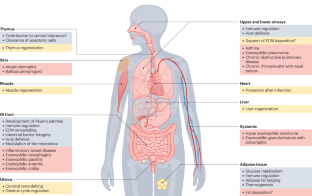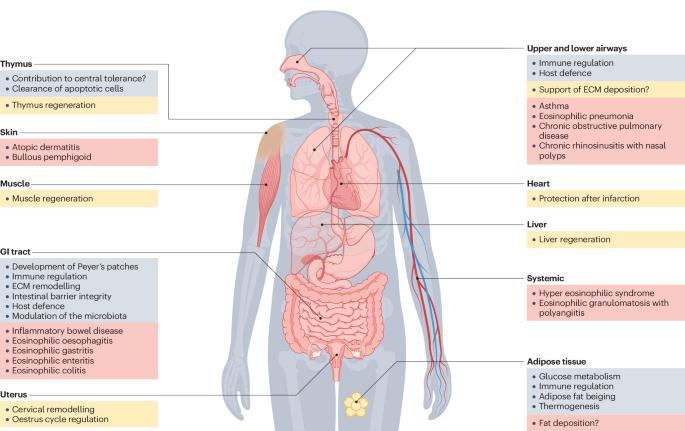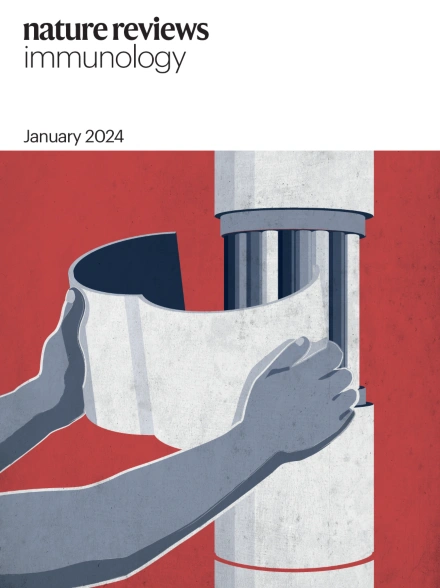Spatial adaptation of eosinophils and their emerging roles in homeostasis, infection and disease
IF 67.7
1区 医学
Q1 IMMUNOLOGY
引用次数: 0
Abstract
Eosinophils are bone marrow-derived granulocytes that are traditionally associated with type 2 immune responses, such as those that occur during parasite infections and allergy. Emerging evidence demonstrates the remarkable functional plasticity of this elusive cell type and its pleiotropic functions in diverse settings. Eosinophils broadly contribute to tissue homeostasis, host defence and immune regulation, predominantly at mucosal sites. The scope of their activities primarily reflects the breadth of their portfolio of secreted mediators, which range from cytotoxic cationic proteins and reactive oxygen species to multiple cytokines, chemokines and lipid mediators. Here, we comprehensively review basic eosinophil biology that is directly related to their activities in homeostasis, protective immunity, regeneration and cancer. We examine how dysregulation of these functions contributes to the physiopathology of a broad range of inflammatory diseases. Furthermore, we discuss recent findings regarding the tissue compartmentalization and adaptation of eosinophils, shedding light on the factors that likely drive their functional diversification within tissues. This Review by Arnold and Munitz discusses the diverse roles of eosinophils in the settings of tissue homeostasis, infection, allergy and cancer. The authors explain the molecular mechanisms that enable eosinophils to adapt to diverse tissue types and conditions, and they consider the therapeutic potential of eosinophil-depleting drugs in the clinic.


嗜酸性粒细胞的空间适应性及其在体内平衡、感染和疾病中的新作用
嗜酸性粒细胞是源自骨髓的粒细胞,传统上与寄生虫感染和过敏等第二类免疫反应有关。新的证据表明,这种难以捉摸的细胞类型具有显著的功能可塑性,并能在不同环境中发挥多种功能。嗜酸性粒细胞主要在粘膜部位广泛参与组织稳态、宿主防御和免疫调节。嗜酸性粒细胞的活动范围主要反映了其分泌介质组合的广度,这些介质包括细胞毒性阳离子蛋白和活性氧,以及多种细胞因子、趋化因子和脂质介质。在此,我们全面回顾了嗜酸性粒细胞的基本生物学特性,这些特性与嗜酸性粒细胞在平衡、保护性免疫、再生和癌症方面的活动直接相关。我们研究了这些功能失调是如何导致各种炎症性疾病的生理病理变化的。此外,我们还讨论了有关嗜酸性粒细胞的组织分区和适应性的最新发现,揭示了可能驱动其在组织内功能多样化的因素。
本文章由计算机程序翻译,如有差异,请以英文原文为准。
求助全文
约1分钟内获得全文
求助全文
来源期刊

Nature Reviews Immunology
医学-免疫学
CiteScore
93.40
自引率
0.40%
发文量
131
审稿时长
6-12 weeks
期刊介绍:
Nature Reviews Immunology is a journal that provides comprehensive coverage of all areas of immunology, including fundamental mechanisms and applied aspects. It has two international standard serial numbers (ISSN): 1474-1733 for print and 1474-1741 for online. In addition to review articles, the journal also features recent developments and new primary papers in the field, as well as reflections on influential people, papers, and events in the development of immunology. The subjects covered by Nature Reviews Immunology include allergy and asthma, autoimmunity, antigen processing and presentation, apoptosis and cell death, chemokines and chemokine receptors, cytokines and cytokine receptors, development and function of cells of the immune system, haematopoiesis, infection and immunity, immunotherapy, innate immunity, mucosal immunology and the microbiota, regulation of the immune response, signalling in the immune system, transplantation, tumour immunology and immunotherapy, and vaccine development.
 求助内容:
求助内容: 应助结果提醒方式:
应助结果提醒方式:


